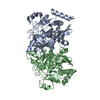+Search query
-Structure paper
| Title | Oligomerization and a distinct tRNA-binding loop are important regulators of human arginyl-transferase function. |
|---|---|
| Journal, issue, pages | Nat Commun, Vol. 15, Issue 1, Page 6350, Year 2024 |
| Publish date | Jul 28, 2024 |
 Authors Authors | Xin Lan / Wei Huang / Su Bin Kim / Dechen Fu / Thilini Abeywansha / Jiemin Lou / Udayakumaran Balamurugan / Yong Tae Kwon / Chang Hoon Ji / Derek J Taylor / Yi Zhang /   |
| PubMed Abstract | The arginyl-transferase ATE1 is a tRNA-dependent enzyme that covalently attaches an arginine molecule to a protein substrate. Conserved from yeast to humans, ATE1 deficiency in mice correlates with ...The arginyl-transferase ATE1 is a tRNA-dependent enzyme that covalently attaches an arginine molecule to a protein substrate. Conserved from yeast to humans, ATE1 deficiency in mice correlates with defects in cardiovascular development and angiogenesis and results in embryonic lethality, while conditional knockouts exhibit reproductive, developmental, and neurological deficiencies. Despite the recent revelation of the tRNA binding mechanism and the catalytic cycle of yeast ATE1, the structure-function relationship of ATE1 in higher organisms is not well understood. In this study, we present the three-dimensional structure of human ATE1 in an apo-state and in complex with its tRNA cofactor and a peptide substrate. In contrast to its yeast counterpart, human ATE1 forms a symmetric homodimer, which dissociates upon binding of a substrate. Furthermore, human ATE1 includes a unique and extended loop that wraps around tRNA, creating extensive contacts with the T-arm of the tRNA cofactor. Substituting key residues identified in the substrate binding site of ATE1 abolishes enzymatic activity and results in the accumulation of ATE1 substrates in cells. |
 External links External links |  Nat Commun / Nat Commun /  PubMed:39068213 / PubMed:39068213 /  PubMed Central PubMed Central |
| Methods | EM (single particle) |
| Resolution | 2.8 - 5.7 Å |
| Structure data | EMDB-41770, PDB-8tzv: EMDB-42071, PDB-8uau: |
| Chemicals |  ChemComp-ZN: |
| Source |
|
 Keywords Keywords | TRANSFERASE / arginylation / ATE1 / apo / TRANSFERASE/RNA / complex / TRANSFERASE-RNA complex |
 Movie
Movie Controller
Controller Structure viewers
Structure viewers About Yorodumi Papers
About Yorodumi Papers







 homo sapiens (human)
homo sapiens (human)